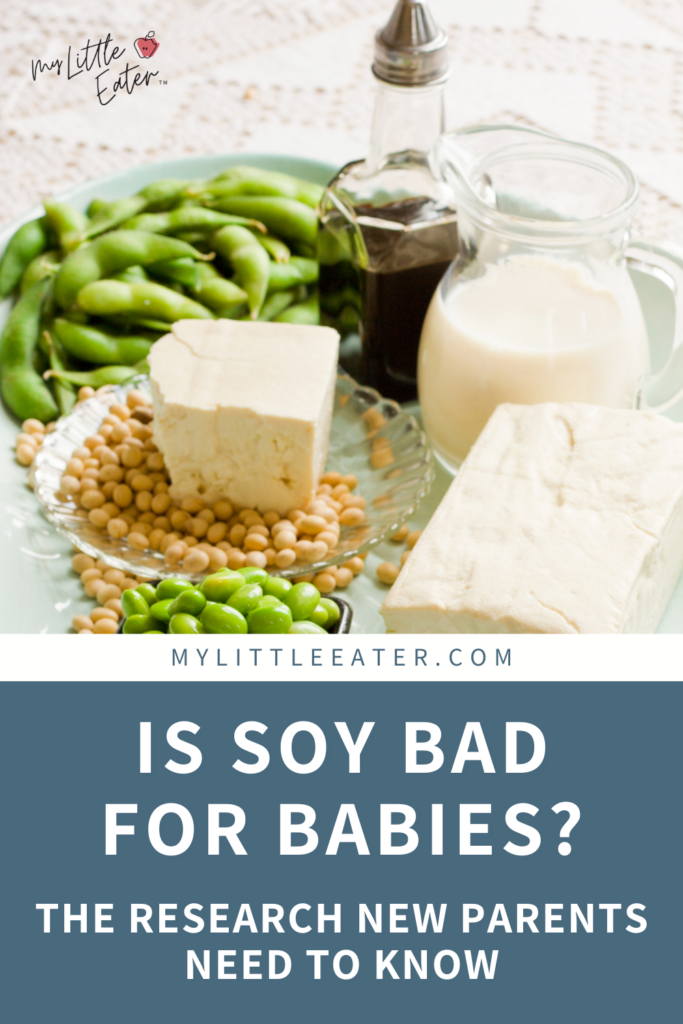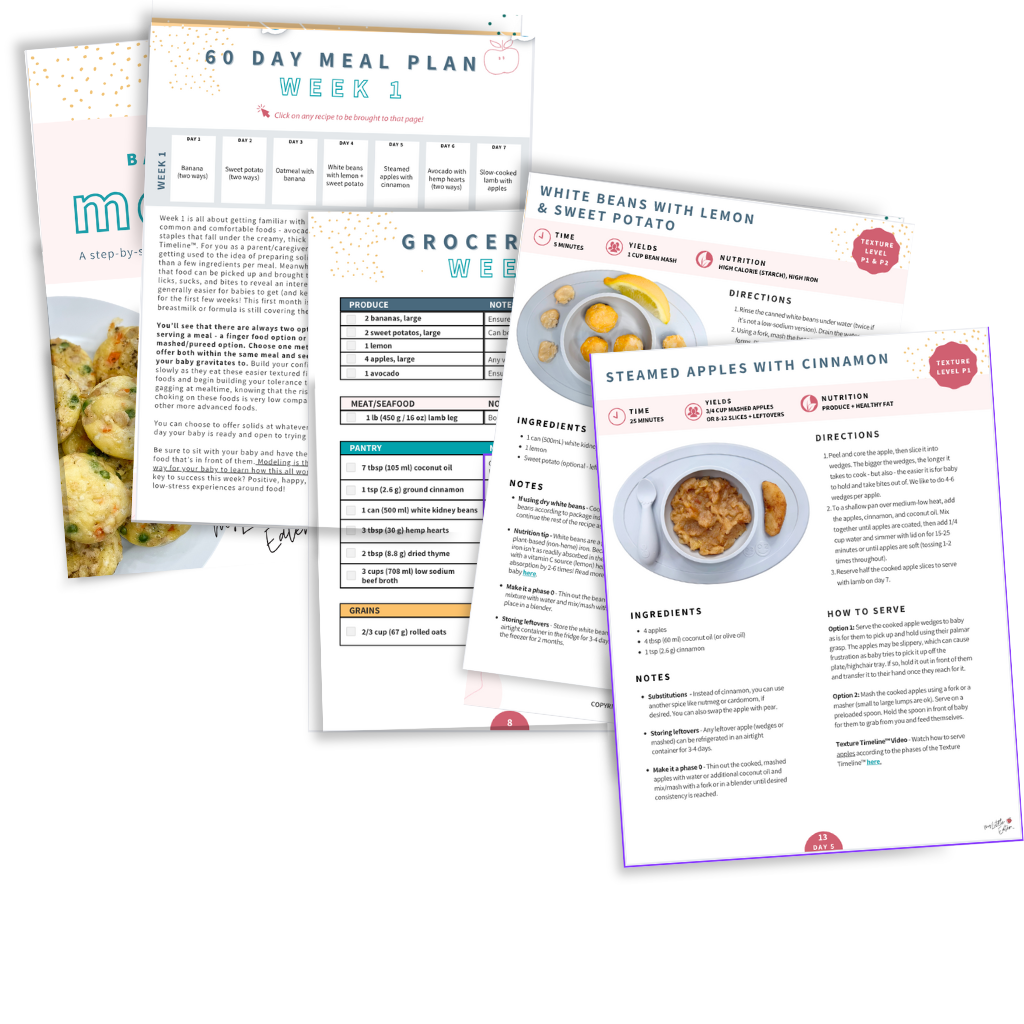This post may contain affiliate links, please view our disclosure policy for more details.
Soy is a food eaten all over the world and is even the first food choice for babies in many cultures, especially in East Asia. It can be eaten as edamame (soybean), tofu, tempeh, miso, natto, or soy milk.
In recent years, tofu and other soy products have become increasingly popular, but tofu has actually been around for more than two thousand years!
Unfortunately, there’s a lot of misinformation found online about soy for babies and toddlers that may leave you with concerns about introducing this food to your baby.
We’ll cover the real research on phytoestrogens in soy, various ways to serve it by age whether you’re starting with purees or finger foods, and all the nutritional information you need to know for maximum benefit. We’re also leaving you with a delicious and easy tofu frittata recipe that your baby or toddler will love!
If your baby is in the stage of starting solids, or soon will be, having lots of recipes to choose from can make the process a whole lot easier!
That’s why we created our 60 Day Baby Led Feeding Meal Plan with weekly grocery lists, puree and finger food options, and specific instructions on how to serve the food safely to your baby.
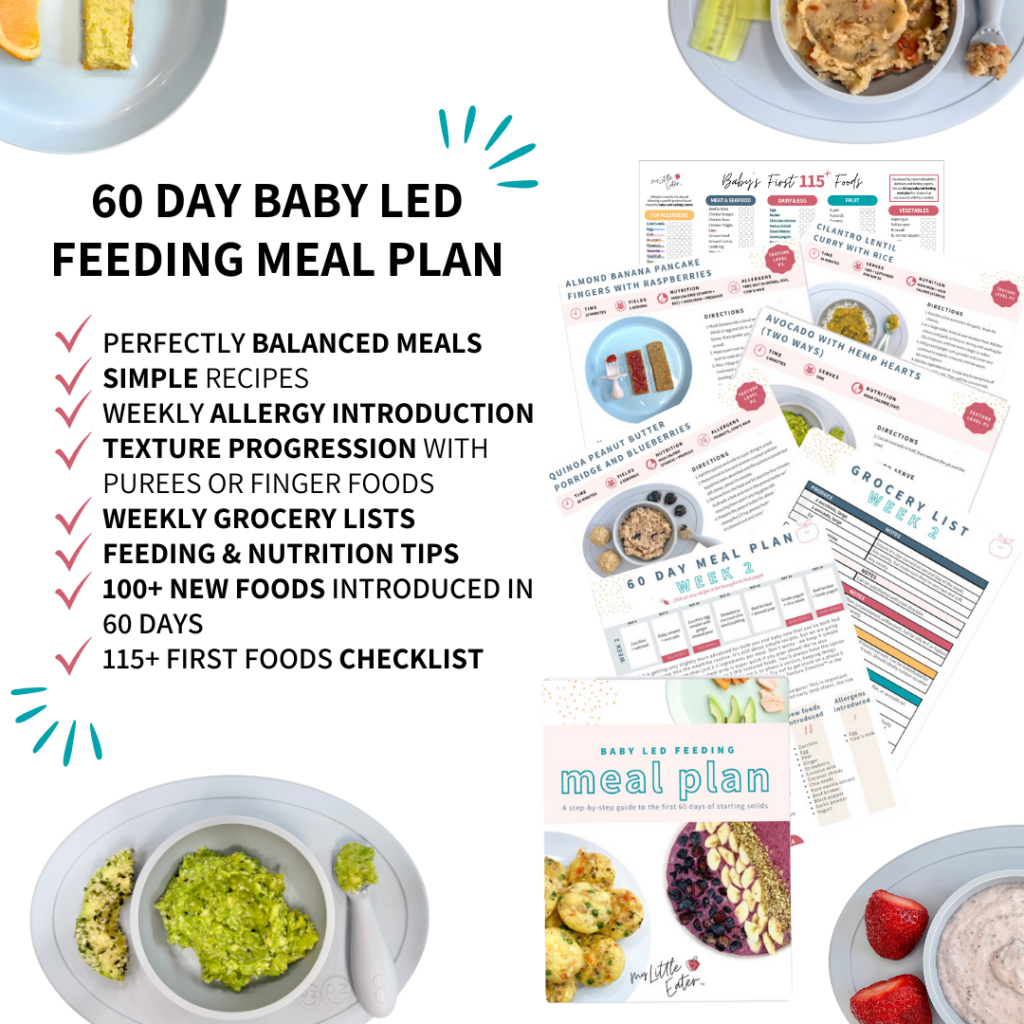
If your baby is in the stage of starting solids, or soon will be, having lots of recipes to choose from can make the process a whole lot easier!
That’s why we created our 60 Day Baby Led Feeding Meal Plan with weekly grocery lists, puree and finger food options, and specific instructions on how to serve the food safely to your baby.

Table of Contents
Can babies have soy?
Yes. Soy can be introduced to your baby as soon as they show all the signs of readiness to start solids, which usually occurs around 6 months of age. In fact, soy is a top allergen that requires a safe and early introduction to help prevent an allergy from developing, so it’s important to serve it near the start of your feeding journey if possible.
With so many different forms of soy products on the market, it’s important to note that not all of them are safe from 6 months old. Some will need to be avoided until one year of age and others are choking hazards that need to be modified before serving.

How often can I serve soy to my baby?
Soy can be offered to your baby daily if desired.
However, we want you to keep in mind that we don’t want to offer the same foods on repeat. This is true for any food, not just soy. It’s important that you offer a variety of foods to your baby to promote a wide acceptance of flavors and textures.
Are phytoestrogens in soy bad for my baby?
The quick answer is no.
But we understand that there’s a lot of misinformation online about phytoestrogens that may leave you feeling unsure about this answer. Let’s clear this up for you.
Soy is a food that’s naturally very high in isoflavones (a type of phytoestrogen), which is a compound that’s similar to estrogen in the body. Because they are similar, phytoestrogens can bind to estrogen receptors which can increase estrogen levels in the body (6).
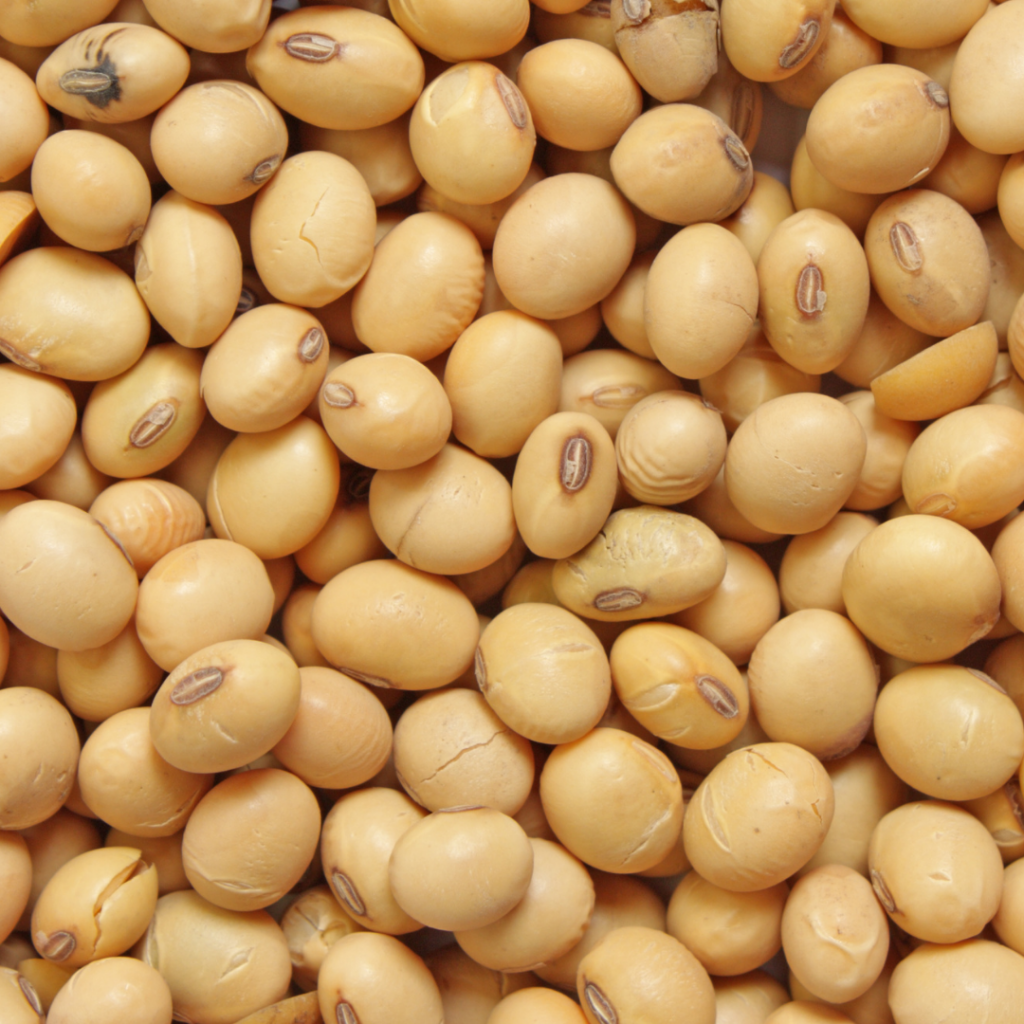
This is where the controversy comes from. There’s a lot of concern about how this increase in estrogen levels will impact hormones, development, and the overall health of children (and adults), particularly boys.
The most recent evidence to date shows that there are no confirmed negative effects of soy’s high isoflavone/phytoestrogen content on our health, including the health of our children.
In fact, isoflavones/phytoestrogens have been associated with anti-cancer benefits (particularly breast, endometrium, and prostate cancer), and may promote bone and heart health (7, 8).
As for whether or not phytoestrogens affect boys specifically, research has not found any negative impact on their hormones. There’s a lack of evidence showing any short-term or long-term negative effects of soy consumption on endocrine (hormone system) function at all (7).
Even though many believe that estrogen is a female hormone, it’s naturally produced in males as well, so it isn’t as though consuming soy is introducing something new to their system (7).
Key Takeaway
Key Takeaway
No research to date recommends a need for limiting soy in babies or toddlers and no evidence suggests any negative effects on development, reproduction, or endocrine function (7).

That being said, more research is still needed to determine if soy is beneficial in all cases, for all people, in different stages, and if that determination is based on the type of soy consumed.
For example, the extent to which isoflavones can be digested depends on the type of bacteria found in your gut (9). And the amount of isoflavones found depends on whether soy is fermented or not and the level of processing of the soy products (9). It’s important that we continue to do research to ensure we are taking factors like these into account when determining the impact of phytoestrogens.
My Little Eater
Recommendation
Recommendation
Offer your baby a balanced diet with a variety of foods including soy as a safe option.
Nutritional benefits of soy foods
Soy products offer many benefits and are healthy for your baby or toddler.

Soy is an excellent source of…
- High-quality, plant-based protein: It contains all the essential amino acids (making it one of the only vegetables that is a “complete protein”) (1).
- Fiber: This is of particular importance for toddlers. While fiber is important for babies too, we want to gradually increase the amount offered and consumed instead of introducing a ton at once. If a baby goes from low fiber to high fiber super quickly, it can lead to gas or bloating and discomfort. Toddlers are much more likely to become constipated, which is why fiber is of particular importance at that age.
- Iron: A crucial nutrient for babies as their daily requirements are so high and because it’s necessary for your baby’s proper brain development. High-iron sources, like soy, should be offered twice daily (when possible) to prevent iron deficiency (2). Soy is a non-heme source and should be paired with a food high in vitamin C (like peppers, oranges, lemon, or broccoli) to boost iron absorption (3).
- Zinc: An important nutrient for kids at all ages and stages of development. Zinc is crucial for your baby’s immune function, wound healing, and overall growth (4).
- Magnesium: Plays an important role in bone development, nerve and muscle function, blood glucose control, and blood pressure regulation (5).
How to serve soy to babies
Since there are so many different soy products that you can offer your baby, each requires a different set of modifications to make them safe to serve. Let’s go through what those are for some of the most common types of soy.
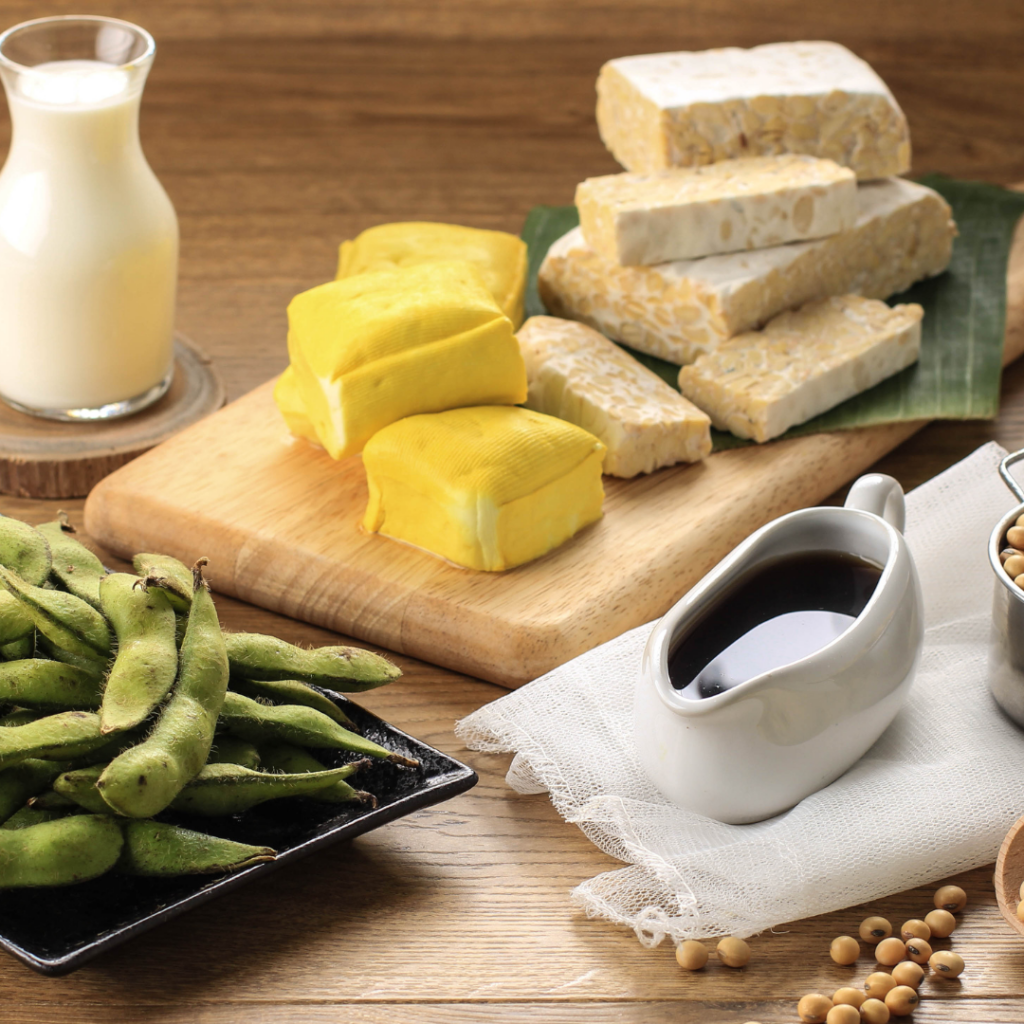
Edamame
Edamame is a choking hazard due to its hard, round shape that can block your baby’s airway. Edamame is also slippery, making it harder for your baby to control it in their mouth, which increases the risk of choking. That said, it can be modified to serve as either a puree or finger food.
Mashed (Utensil)
Blend or hand-mash steamed and soft edamame and offer it on its own in a bowl or mixed with Greek yogurt, oil, milk, breast milk, or formula. Offer this to your baby on a preloaded spoon. You can also spread the mash on toast.
Strips (Palmar Grasp)
You can incorporate soybeans into a homemade bean burger or a fritter for a high-protein and nutrient-rich food. Cut it into finger-shaped strips for your baby to self-feed on.
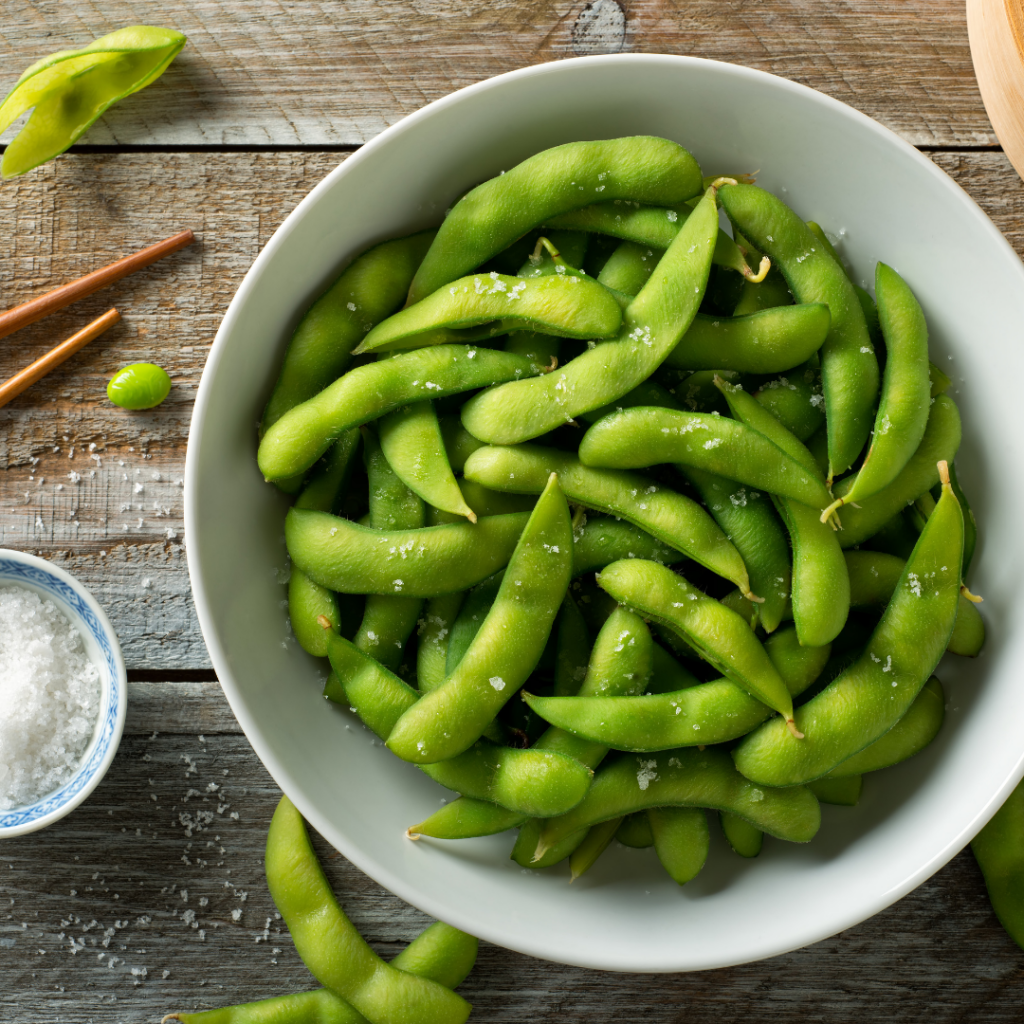
Diced (Pincer Grasp)
Once your baby has developed their pincer grasp, you can offer boiled or steamed halved edamame, or whole edamame that has been mashed or flattened with a fork. Your baby can practice picking them up between their index finger and thumb and bringing them to their mouth to eat.
Note: The outer clear skins on edamame beans are not a choking hazard, but may cause your baby to gag as they get used to this new texture. If you feel more comfortable with it, you can remove them before offering.
Tofu
In terms of texture options, silken, soft, medium, or firm tofu are best for babies and each provides a different texture experience.
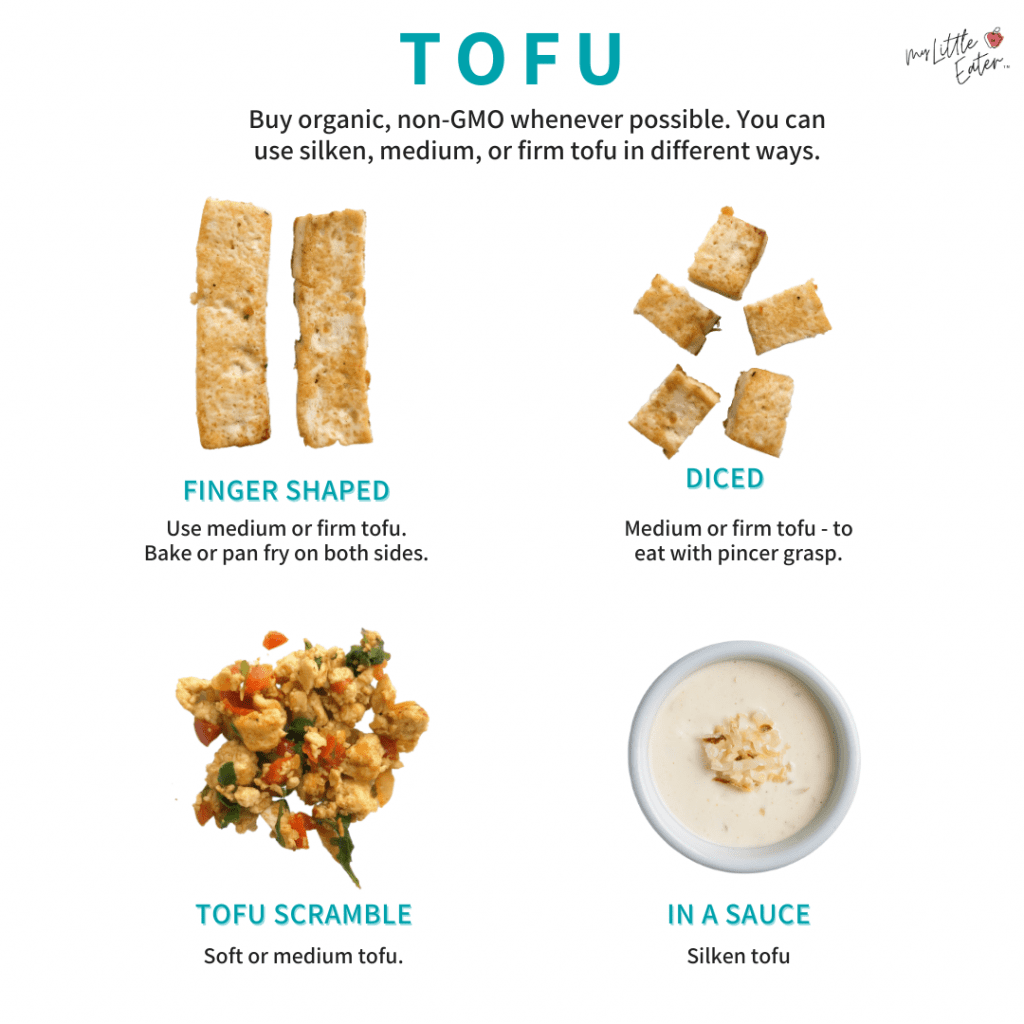
Mashed (Utensil)
You can mix silken tofu or soft tofu into other puréed or mashed foods and offer it to your baby on a preloaded spoon. Silken or soft tofu can be used for smoothies or soups and is a great thickening agent for purées.
This is considered a phase 0 food on the Texture Timeline™ and requires no chewing by your baby.
Strips (Palmar Grasp)
Cut firm or extra firm tofu into finger-shaped strips (1-2 finger lengths wide) that will make it easier for your baby to hold with their palmar grasp to self-feed. You can serve it raw or lightly pan-fried on the stove in some oil, adding some flavor to the tofu with different spices. We like cumin or paprika, or you can coat it with nutritional yeast!
If you use firm tofu for this, it would be considered Phase 2 of the Texture Timeline™. This requires some mashing with the gums and tongue.
If you choose extra firm tofu, it would be considered Phase 3 on the Texture Timeline™ as it may be a harder texture to manipulate.
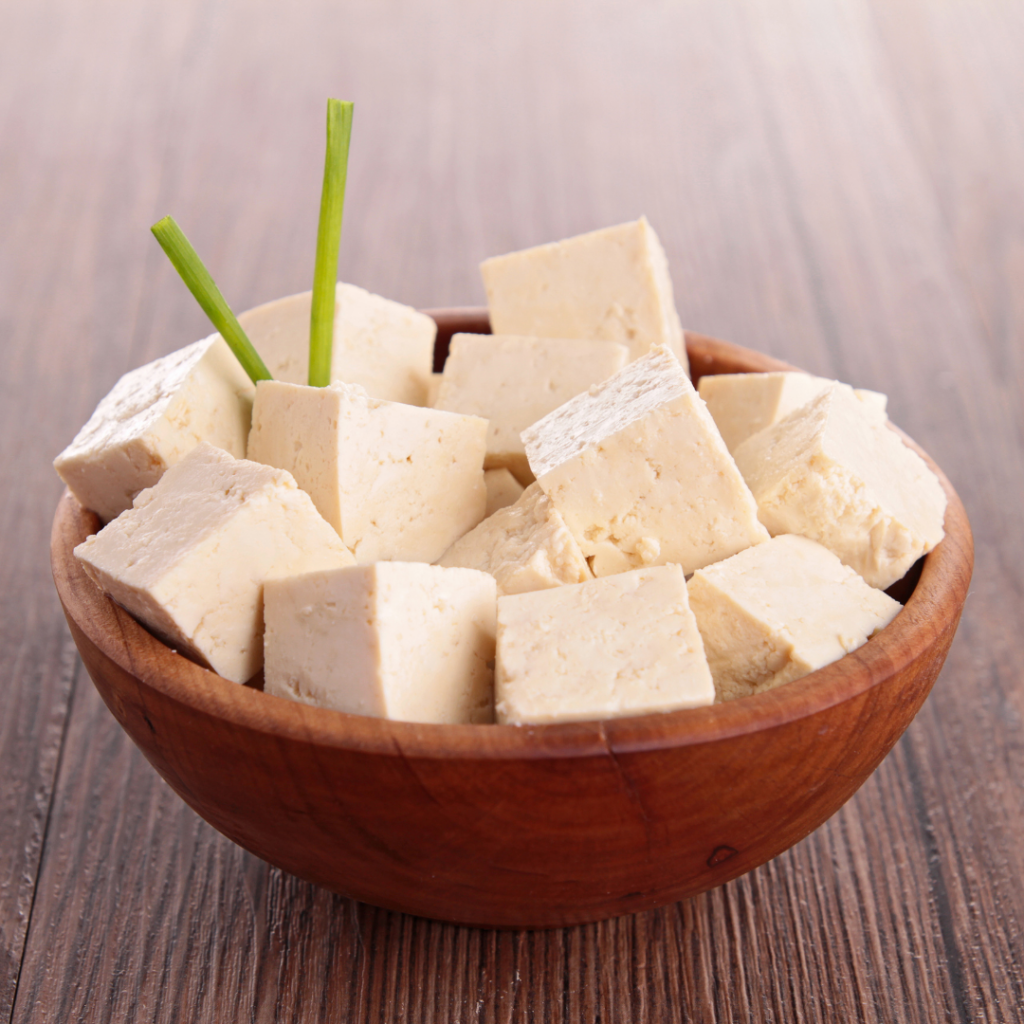
Diced (Pincer Grasp)
Once your baby develops their pincer grasp, the tofu can be cut into smaller bite-sized pieces so that they can pick them up using their index finger and thumb.
Another option with medium to extra firm tofu is to crumble it to form a ground beef-like consistency. From here you can let your baby practice picking up the pieces with their pincer grasp.
Serve the diced tofu as is in a bowl mixed with different spices and seasonings, fry it as a tofu scramble, or add it to baby-friendly soups, pasta, casseroles, and other recipes.
PS – you can find a great tofu frittata recipe below (from our 60 Day Baby Led Feeding Meal Plan)!
Top Tip!
Top Tip!
To prepare medium to extra firm tofu for your baby, you have the option of pressing the tofu to drain out the water content. This keeps the texture more firm when cooking.
This is a good option for when your baby is a bit more experienced and you want a bit of a crispier outer texture.
To do this, you can wrap the tofu in a kitchen towel and place a stack of books or a heavy pot on top for 10-20 minutes to allow water to drain from it.
To press out more water easily, freeze the tofu for at least one day. Once frozen, let the tofu thaw in the fridge for another day. Now, it’s ready to press. The extra freezing and thawing steps help you to remove more water and allow the tofu to take on more flavor when cooking.
Tempeh
Tempeh is made from fermented soybeans and has a cake-like texture that is great for self-feeding.
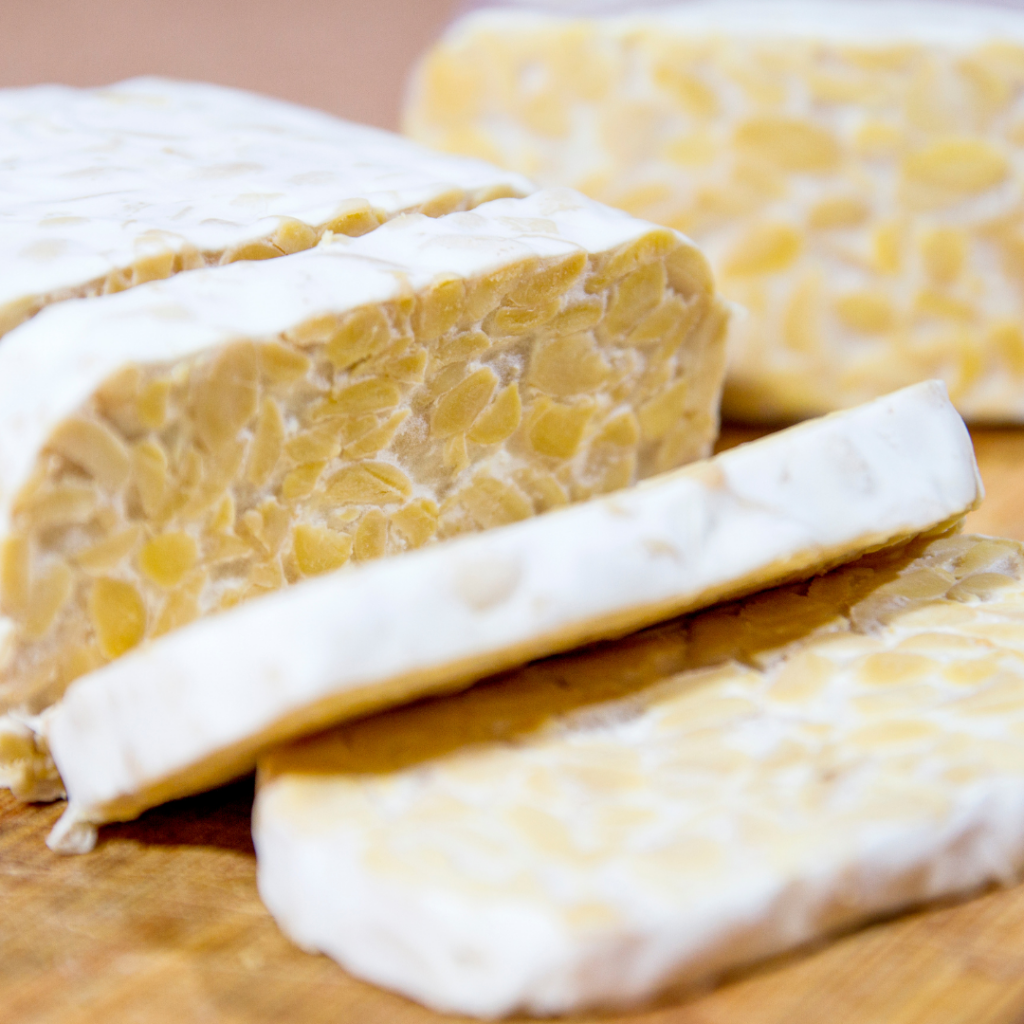
Strips (Palmar Grasp)
To serve it to your baby, cut the tempeh into finger-shaped strips (1-2 finger lengths wide), and cook them in a pan with some butter or oil until softened. This shape will make it easier for your baby to hold onto and safer for them to self-feed on.
Diced (Pincer Grasp)
Once your baby has developed their pincer grasp, the cooked tempeh can be cut into smaller bite-sized pieces that they can pick up using their index finger and thumb.
Tempeh can also be crumbled into small pieces and can be used as a substitution for ground beef. You can experiment with adding it to casseroles, pasta, or braised dishes that the whole family can enjoy together.
What to look for when buying soy
There are many variations of soy on the market, and as with anything, some are better than others. Let’s break down what you should look for when shopping for soy for your baby.
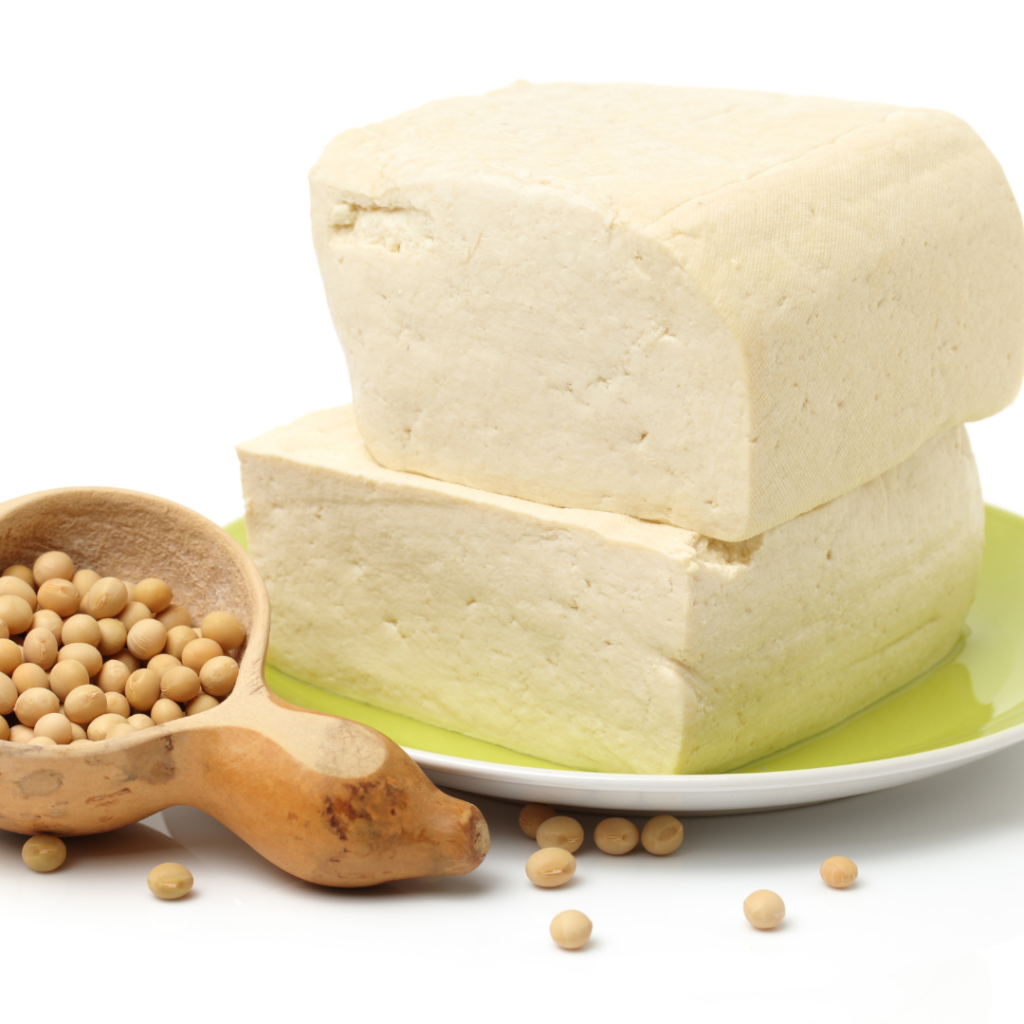
Fortified soy products
It can be helpful (though not necessary) to look for tofu that’s been made in a calcium-fortified liquid (like calcium sulfate). This can be especially important if your baby or toddler is on a dairy-free diet and needs added calcium sources.
The same is true if opting to serve soy milk over dairy milk. Choose an option fortified with calcium.
Processed vs. unprocessed forms of soy
We recommend opting for unprocessed, or the least processed, forms of soy you can find, whenever possible. From a health perspective, there’s usually a difference between processed and unprocessed soy products, especially for babies and toddlers.
Generally, the less processed a soy food is, the more vitamins, minerals, and antioxidants it contains. On the other hand, the more processed it is, the more salt, sugar, and unnecessary additives and fillers it likely contains – and – the fewer nutrients available.
Soy products that are more commonly eaten in Western countries like Canada and the US are soy-based meat substitutes, soy milk, soy cheese, and soy yogurt. Some of these are made from soy milk, while others use processed soy in the form of isolated soy protein or soy protein concentrate.
Some examples of unprocessed (or minimally processed) versions of soy include:
- Tempeh
- Tofu
- Edamame
- Bean sprouts
- Miso
- Fermented soy products (like soybean paste and natto)
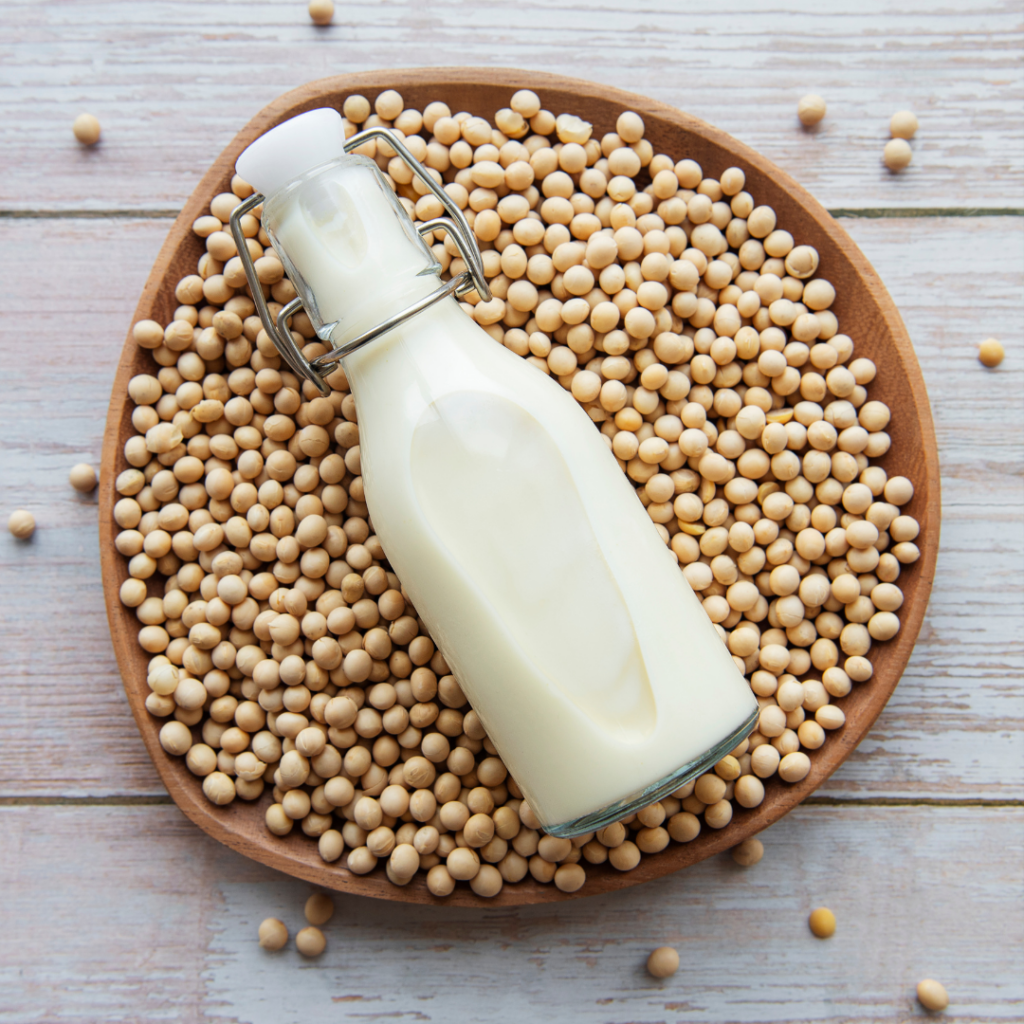
Note: Fermented soy products have been cultured with beneficial bacteria, yeast, or mold that can improve their digestibility and absorption in the body – including isoflavone content – which we love (10)! Fermented foods help populate your baby’s gut with healthy bacteria that positively affect their immunity, metabolism, hormonal system, and more (11, 12).
Soy milk and soy-based yogurt sit on the fence between being a minimally processed and processed soy product (depending on the brand and ingredients used). To find the healthiest soy milk and yogurt for your baby or toddler, look for minimal added sugar, sodium, and gums or thickeners, and opt for organic or non-GMO options when possible. For babies, you’ll want to purchase full-fat, fortified soy milk and yogurt for maximum nutritional benefit.
Examples of highly processed soy products include:
- Soy protein isolate and soy protein concentrate
- Soy oils
- Faux meat and textured vegetable proteins
- Soy sauce
- Tamari
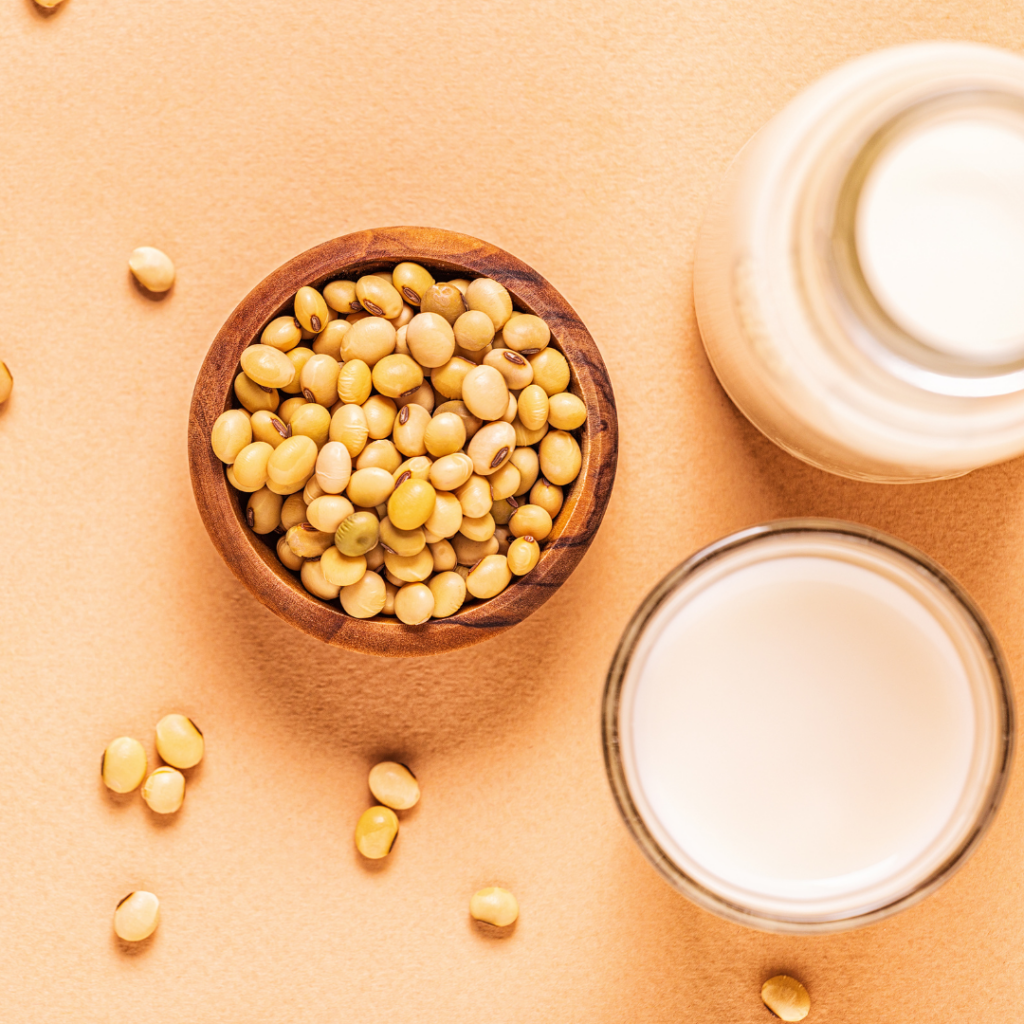
In general, you’ll want to avoid offering highly processed soy products to your baby until 2 years or older.
Organic vs. non-organic soy
Soybean crops contain high levels of pesticides, so organic soy products can help limit exposure for babies. This is beneficial because babies may be more susceptible to harm from these chemicals (13).
While many crops have varying levels of pesticide use, soy crops are heavily sprayed with pesticides, specifically one called glyphosate, which is one of the most widely used pesticides (14).

Glyphosate is classified as a “probable carcinogen to humans” by the World Health Organization (15). While glyphosate levels are regulated by the Environmental Protection Agency, products are not tested regularly to ensure safe levels.
Because of the high pesticide use on soy crops and the unknown outcomes of chronic exposure to glyphosate, we recommend buying organic, non-GMO soy for your baby (if possible) to reduce the risk (16).
We completely understand that organic foods are often more expensive, so if cost is a factor for you, please don’t worry. There are still benefits to consuming non-organic soy in moderation, especially when considering that we really want your baby to consume a varied diet to broaden their palate and provide more nutrition.
Read more about our recommendations for organic food for babies.
Is soy a top allergen?
Yes, soy is a top allergen.
Even though any food can trigger an allergic reaction, 10 foods have been identified as being the most common allergies (also termed priority allergens). Soy is included in this list (17).
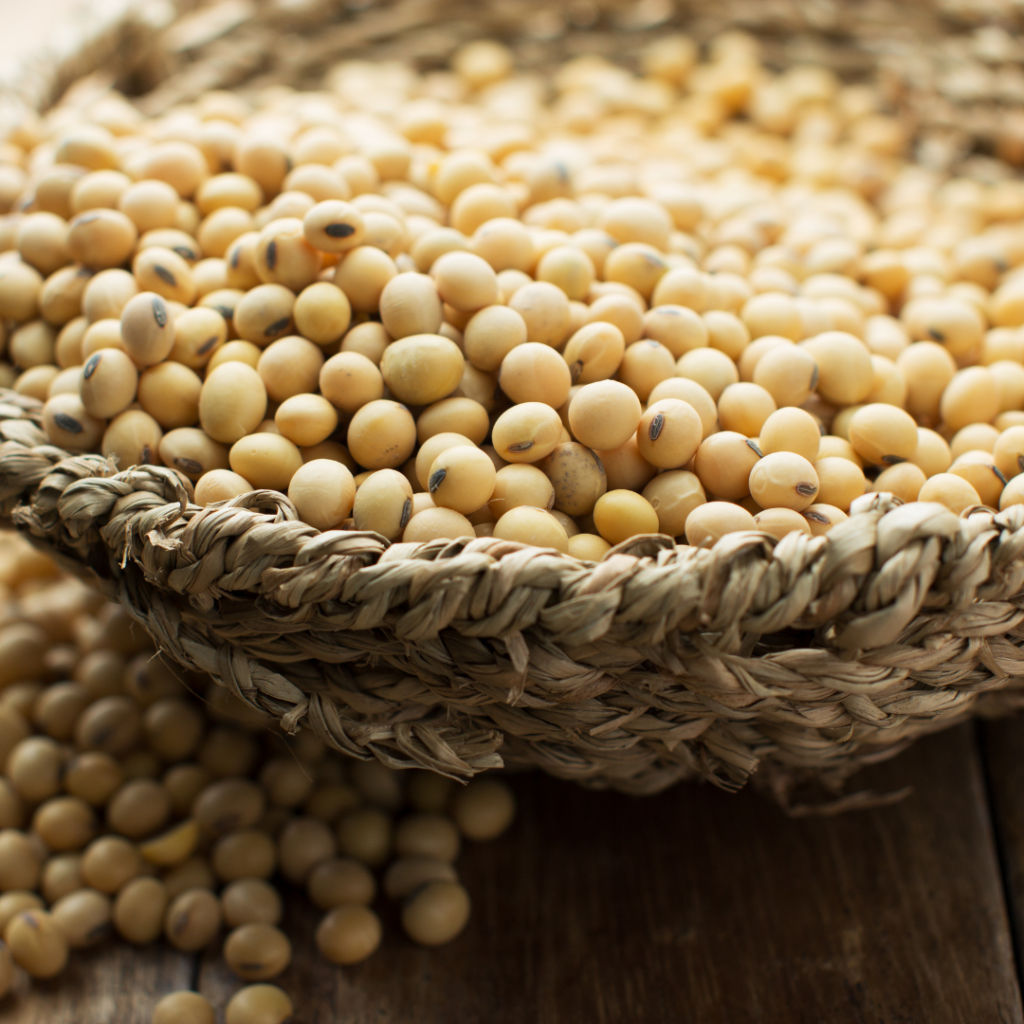
This is why it’s important to introduce soy as early as possible once your baby starts solids. You’ll also need to continue offering soy often once it’s ruled out as an allergen to help prevent an allergy from developing later on (18).
When introducing an allergen such as soy to your baby for the first time, only offer one new allergenic food at a time, but other non-highly allergenic foods can be offered with it.
This ensures that you can easily detect which food (if any) causes an allergic reaction.
Learn more about our recommended protocol for introducing highly allergenic foods.
Common signs and symptoms of an allergic reaction include (19):
- Hives, itching, and eczema.
- Stomach problems – cramps, nausea, vomiting, diarrhea.
- Coughing and wheezing.
- Tightness in the throat.
- Anaphylaxis (a severe, life-threatening allergic reaction; signs include trouble breathing, swelling of the skin, etc. (20)).
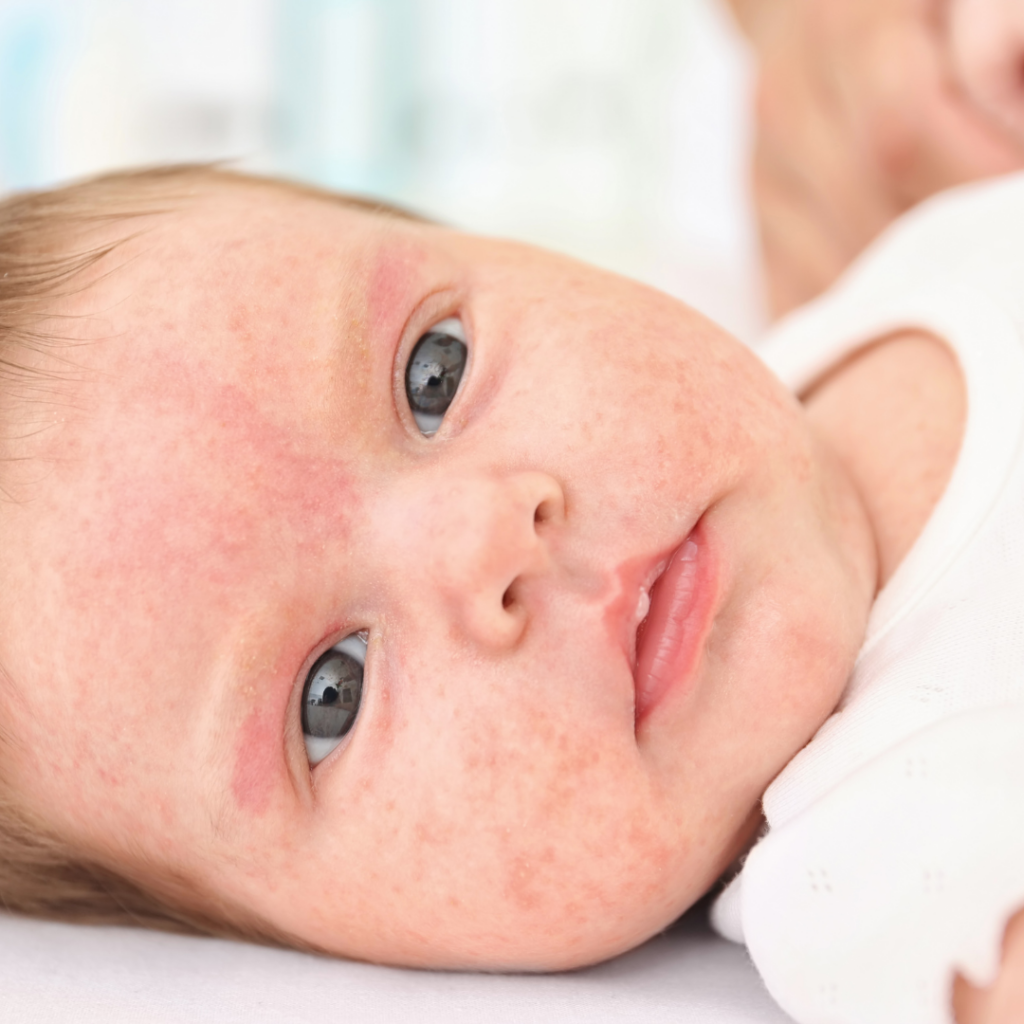
If your baby experiences any of the above symptoms while eating soy (or afterward), call your doctor or seek medical help immediately.
Your doctor may refer your baby to an allergist to confirm the diagnosis of a soy allergy and determine the next steps. Treatment for a soy allergy includes complete elimination and avoidance of soy products (21). Your allergist may also make a plan for reintroducing soy products to your child at the right time (22).
Food protein-induced enterocolitis syndrome (FPIES)
The typical allergic reaction described above is associated with the body creating antibodies (proteins that eliminate unwanted substances) when the food enters the body (23). There’s another type of reaction that can occur called Food Protein-Induced Enterocolitis Syndrome, or FPIES.
FPIES is a non-IgE-mediated food allergy (the body does not produce antibodies) that involves the gastrointestinal tract (24). One of the most common causes of FPIES is in reaction to soy.
Symptoms include severe vomiting and diarrhea that, left untreated, can lead to dehydration (24). These symptoms usually happen 2-3 hours after eating the food (21).

If your child is diagnosed with FPIES in reaction to soy, similar to a typical allergy, your doctor or specialist will advise you to avoid soy products for your baby. However, research shows that children usually start to tolerate the food within 3 – 4 years of life, although this can vary greatly (21, 24).
How common is a soy allergy in children?
Soy allergy is most common in infants and occurs in less than 1% of children (22, 25). While some will have the soy allergy for life, most children outgrow their soy allergy by 10 years of age (22).
One study found that 25% of children outgrew their allergy by 4 years of age, and 69% of children outgrew their soy allergy by age 10 (26).
Does having other allergies increase the risk of a soy allergy?
In the general population, less than 1% of children have been found to develop a soy allergy (21). But, if your baby already has a diagnosed food allergy, research shows that there does seem to be a small relationship between certain allergies (or allergic conditions) and soy allergies.

Cow’s milk and soy allergy: Cow’s milk is one of the most common allergies for children to have (27). Research has found that children with a cow’s milk allergy have a 10-14% chance of also reacting to soy-based products (7, 21, 28, 29). So in this case, there is an increased risk, although it’s small.
Always discuss the introduction of allergens with your allergist after the initial diagnosis to determine how to proceed.
Peanut and soy allergy: Soy and peanuts are both part of the legume family. Studies found that approximately 6-11% of children with a peanut allergy were also allergic to soy (21, 30). This shows that there is a small increase in the likelihood that your child will develop a soy allergy if they have a previously diagnosed peanut allergy.
Atopic dermatitis and soy allergy: Atopic dermatitis, a type of eczema, is a chronic skin disorder (31). Eczema affects around 15 to 20% of babies under 2 years of age and can increase the chance your baby develops a food allergy (31, 32).
Research has shown that children with atopic dermatitis are more likely to develop a soy allergy (21). In fact, 40% of children with atopic dermatitis also had an allergy to eggs, cow’s milk, soy, or wheat (21).

As we mentioned before, it’s important to introduce soy (and other highly allergenic foods) as early as possible once starting solids and to continue to offer these foods to your baby often to avoid a reaction developing. Speak to your baby’s doctor if you have any concerns about introducing soy to your baby with a pre-existing allergy.
Foods to be cautious of that may contain soy
If your baby has an allergy to soy, you’ll be instructed to completely avoid soy products. Unfortunately, soy is an ingredient in many foods and can sometimes be hidden in the ingredient list.
The following is a list of foods that often contain soy. If your baby has an allergy to soy, you’ll need to get in the habit of checking the ingredient label on these foods – and really most foods – until you figure out which are safe. (22, 33).
Feel free to pin this to save for later, or click the image to download it right to your device!
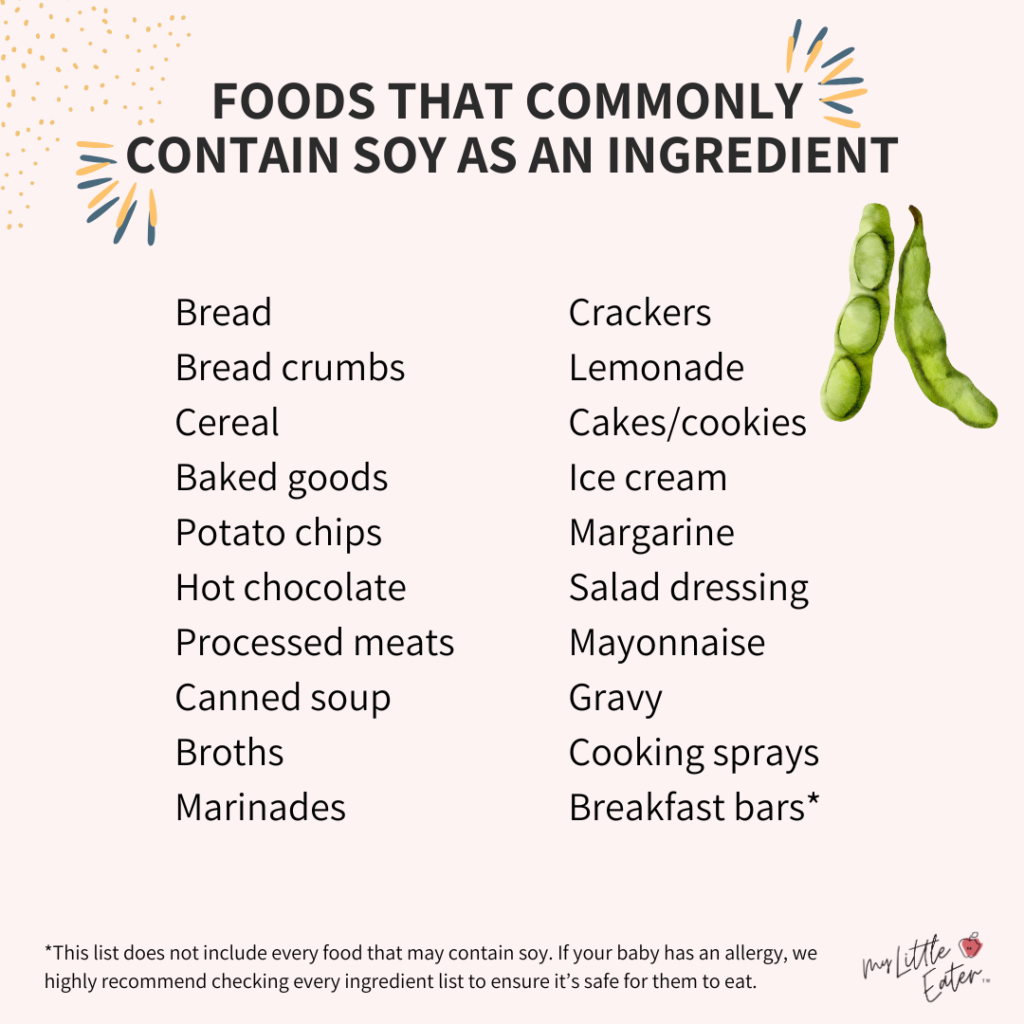
In Canada and the U.S, it’s required for food products that contain soy to have “contains soy” on the packaging. Foods that could have come into contact with soy during processing or manufacturing must be labelled with “may contain soy”. This will help you clearly identify which foods to avoid for your child with a soy allergy (22, 34).
Now, there are certain refined soy products that may not cause a reaction in your child if they have a soy allergy, such as soy oil and soy lecithin (22). Please consult your allergist before offering your child any food with these ingredients, just to be safe.
Soy FAQs
Is soy infant formula a good option for my baby?
The American Academy of Pediatrics (AAP) supports the use of soy infant formula for term infants who aren’t able to get breast milk, aren’t able to tolerate cow’s milk-based formulas, or if a dairy-free diet is preferred for cultural or other reasons (7).
Soy-based infant formula is also indicated for babies with conditions that interfere with proper carbohydrate metabolism, such as galactosemia or hereditary lactase deficiency (which are both rare) (27).
In these special circumstances, soy-based formulas are deemed safe and healthy. They have been found to promote normal growth and development, bone health, reproduction, endocrinology (hormone), immune, and neurological outcomes for babies (6).
BUT – there are some considerations to keep in mind for soy-based formulas.
Babies who are allergic to cow’s milk have a 10 to 14% chance of also being allergic to soy (7). Because of this, the preferred formula option for babies with a cow’s milk allergy is to try a hydrolyzed protein formula.
The cow’s milk proteins in a hydrolyzed protein formula are broken down so as not to cause the body to recognize them as an allergen (7). Therefore, the body will most likely not react as it normally would and babies with a cow’s milk allergy can typically consume this without any symptoms developing.
Additionally, more research is still needed regarding isoflavones/phytoestrogens, so there’s still some debate as to whether or not soy protein formulas will have any negative effects.
Therefore, cow’s milk formula is generally recommended over soy-based formula for most babies, whenever possible (7). At My Little Eater, we agree with this recommendation and encourage choosing a cow’s milk-based formula when able.
Can my baby have soy milk?
Soy milk, along with other non-dairy milk and cow’s milk, can be used in smaller quantities in recipes or when cooking for your baby. However, no type of milk should be offered to your baby as a beverage under one year of age (35).
This is because offering soy or other milk can displace breast milk or formula from your baby’s diet. Only small amounts of water in a cup should be offered to your baby as a beverage outside of breast milk or formula before 1 year of age.
After 1 year of age, soy milk and other fortified milk alternatives can be offered as a beverage. Children who have a cow’s milk allergy or who are on a vegan diet may use soy milk as a cow’s milk replacement. It’s a good source of calcium, protein, vitamin D, and some fat. Soy milk offered under 2 years of age should be fortified, unflavored, and contain full fat.
Can my baby have soy sauce?
As mentioned above, soy sauce and tamari are soy products that are best to avoid giving to your baby until after 12 months. This is due to the high salt content in these products.
While a small taste of soy sauce or tamari in a recipe isn’t going to hurt your baby, we recommend swapping them with coconut liquid aminos. While still high in salt, coconut liquid aminos contains less sodium than soy sauce or a low-sodium tamari.
Can you eat raw tofu?
Yes, your baby (and you!) can eat raw tofu.
When you buy tofu commercially prepared in grocery stores, it’s ready to eat safely straight out of the package if you choose. This is because it’s usually pasteurized during processing to prolong shelf life and kill harmful bacteria.
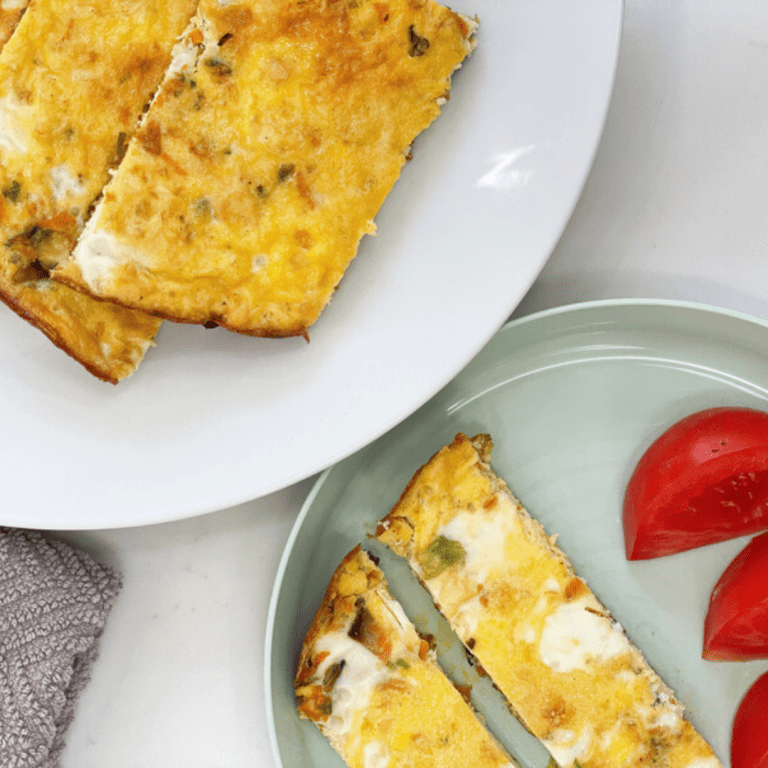
Tofu Frittata with Tomato Wedges
Equipment
- 1 skillet
- 1 small bowl
Ingredients
- 2 tsp. olive oil
- ¼ cup white mushrooms (sliced)
- ½ cup carrots (shredded)
- 2 tbsp. green onion (finely chopped)
- ½ pack firm tofu
- 4 eggs
- 2 tbsp. low-sodium soy sauce
- 1 tomato (cut in large wedges with skin on)
Instructions
- Preheat the oven to 375°F.
- Heat oil in an oven safe, non-stick skillet. Add in mushrooms, carrots, and green onion. Sauté 3-5 minutes or until carrots are soft.
- Drain and press the tofu by hand, using paper towel. Using a fork, or your hands, crumble the tofu and add to the skillet.
- In a small bowl, whisk the eggs and soy sauce. Press the vegetable and tofu mixture in an even layer in the skillet, then pour the egg mixture overtop making sure to cover completely. Cook for 2-3 minutes or until the egg begins to cook around the edges.
- Place the pan in the oven and bake for 8-10 minutes, or until eggs are cooked through. Cut into fingers, pair with tomato wedges, and enjoy!
If you’re looking for more recipe ideas to offer your baby a variety of foods each day, we’ve got you covered with our 60 day baby led feeding meal plan. It includes over 60 recipes, the strategic introduction of the top allergens (including soy!), a gradual progression in textures using our signature Texture Timeline™, weekly grocery lists, and more!

Was this helpful? Pin it to Pinterest for later!
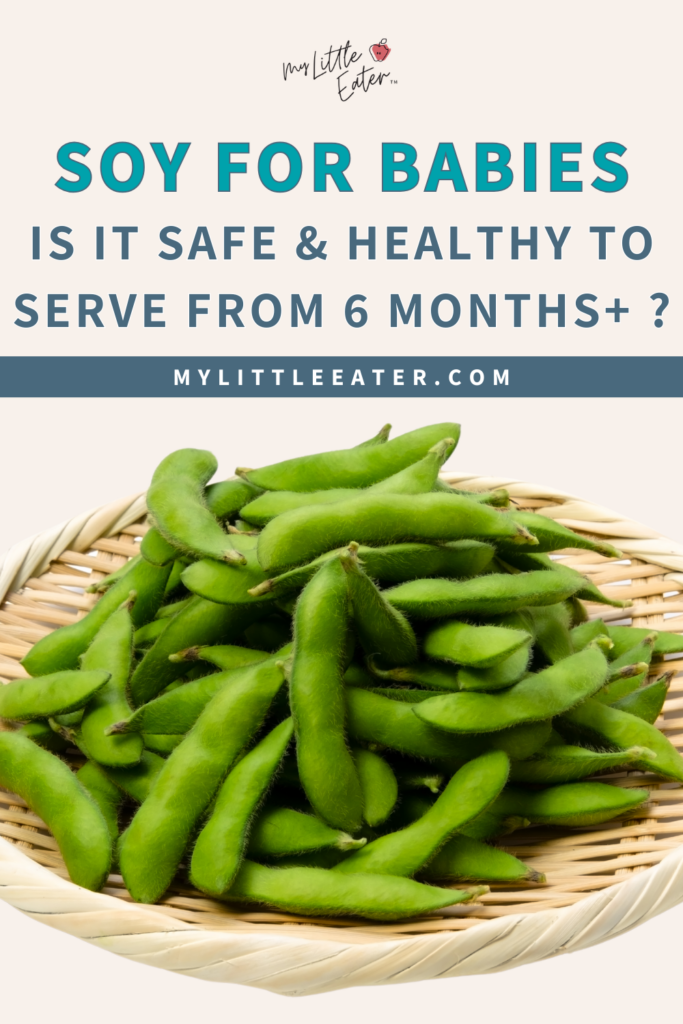
References
- Cleveland Clinic. (n.d.). What are complete proteins? https://health.clevelandclinic.org/do-i-need-to-worry-about-eating-complete-proteins
- McCann S, Perapoch Amadó M, Moore SE. The Role of Iron in Brain Development: A Systematic Review. Nutrients. 2020 Jul 5;12(7):2001. doi: 10.3390/nu12072001. PMID: 32635675; PMCID: PMC7400887.
- Centers for Disease Control and Prevention. (2024, February 23). Iron. Retrieved August 30, 2024, from https://www.cdc.gov/nutrition/infantandtoddlernutrition/vitamins-minerals/iron.html
- Centers for Disease Control and Prevention. (2022, March 11). Zinc. Retrieved August 30, 2024, from https://www.cdc.gov/nutrition/infantandtoddlernutrition/vitamins-minerals/zinc.html
- National Institutes of Health. (2022, June 2). Magnesium. Retrieved August 30, 2024, from https://ods.od.nih.gov/factsheets/Magnesium-HealthProfessional/
- Verduci, E., Di Profio, E., Cerrato, L., Nuzzi, G., Riva, L., Vizzari, G., D’Auria, E., Gianni, M. L., Zuccotti, G., & Peroni, D. (2020). Use of soy-based formulas and cow’s milk allergy: Lights and shadows. Frontiers in Pediatrics, 8(591988). https://doi.org/10.3389/fped.2020.591988
- Bhatia, J., & Greer, F. (2008). Use of soy protein-based formulas in infant feeding. Pediatrics, 121(5), 1062-1068. https://doi.org/10.1542/peds.2008-0564
- Cleveland Clinic. (2023, September 14). 5 reasons to eat more tofu. Retrieved August 30, 2024, from https://health.clevelandclinic.org/tofu-benefits
- Higdon, J. (2016, October). Soy Isoflavones. Oregon State University. Retrieved August 30, 2024, from https://lpi.oregonstate.edu/mic/dietary-factors/phytochemicals/soy-isoflavones#
- Kohli, V., & Singha, S. (2024). Protein digestibility of soybean: How processing affects seed structure, protein and non-protein components. Discover Food, 4(7). https://link.springer.com/article/10.1007/s44187-024-00076-w
- Paul, A. K., Lim, C. L., Apu, A. I., Dolma, K. G., Gupta, M., Pereira, M. d-L., Wilairatana, P., Rahmatullah, M., Wiart, C., & Nissapatorn, V. (2023). Are fermented foods effective against inflammatory diseases? International Journal of Environmental Research and Public Health, 20(3). doi: 10.3390/ijerph20032481.
- Jalili, M., Nazari, M., & Magkos, F. (2023). Fermented foods in the management of obesity: Mechanisms of action and future challenges. International Journal of Molecular Sciences, 24(3). 2665. https://doi.org/10.3390/ijms24032665
- National Pesticide Information Center. (2022, August 11). Pesticides and Children. Retrieved August 30, 2024, from http://www.npic.orst.edu/health/child.html
- Carex Canada. (n.d.). Glyphosate Profile. Retrieved August 30, 2024, from https://www.carexcanada.ca/profile/glyphosate/
- World Health Organization. (2018, July 19). IARC Monograph on Glyphosate. Retrieved August 30, 2024, from https://www.iarc.who.int/featured-news/media-centre-iarc-news-glyphosate/
- The Organic Center. (2020, April 13). Organic soybeans reduce the risks associated with glyphosate use, while glyphosate-tolerant soybean production puts more glyphosate into the food system than previously reported, Retrieved August 30, 2024, from https://www.organic-center.org/research/organic-soybeans-reduce-risks-associated-glyphosate-use-while-glyphosate-tolerant-soybean
- Government of Canada. (2023, April 18). Common food allergens. Retrieved August 30, 2024, from https://www.canada.ca/en/health-canada/services/food-nutrition/food-safety/food-allergies-intolerances/food-allergies.html
- Food Allergy Canada. (2019, October). Early introduction of allergens: FAQs for families. Retrieved August 30, 2024, from https://foodallergycanada.ca/wp-content/uploads/EarlyIntro_Web.pdf
- Cleveland Clinic. (2022, September 15). Soy Allergy. Retrieved August 30, 2024, from https://my.clevelandclinic.org/health/diseases/11320-soy-allergy
- Cleveland Clinic. (2023, October 17). Anaphylaxis. Retrieved August 30, 2024, from https://my.clevelandclinic.org/health/diseases/8619-anaphylaxis
- Kattan, J. D., Cocco, R. R., & Jarvinen, K. M. (2012). Milk and soy allergy. Pediatric Clinics of North America, 58(2), 407-426. doi: 10.1016/j.pcl.2011.02.005
- Government of Canada. (2016, August 31). Soy – A priority food allergen. Retrieved August 30, 2024, from https://www.canada.ca/en/health-canada/services/food-nutrition/reports-publications/food-safety/priority-food-allergen.html
- Cleveland Clinic. (2022, May 6). Antibodies. Retrieved August 30, 2024, from https://my.clevelandclinic.org/health/body/22971-antibodies
- American College of Allergy, Asthma, & Immunology. (2019, March 21). Food Protein-Induced Enterocolitis Syndrome (FPIES). Retrieved August 30, 2024, from https://acaai.org/allergies/allergic-conditions/food/food-protein-induced-enterocolitis-syndrome-fpies/’
- Sicherer, S. H., & Sampson, H. A. (2006). Food allergy. Journal of Allergy and Clinical Immunology, 117(2), 470-475. https://doi.org/10.1016/j.jaci.2005.05.048
- Savage, J. H., Kaeding, A. J., Matsui, E. C., & Wood R. A. (2010). The natural history of soy allergy. The Journal of Allergy and Clinical Immunology, 125(3), 683-686. https://www.jacionline.org/article/S0091-6749(10)00007-2/fulltext
- Gupta, R. S., Springston, E. E., Warrier, M. R., Smith, B., Kumar, R., Pongracic J., & Holl, J. L. (2011). The prevalence, severity, and distribution of childhood food allergy in the United States. Pediatrics, 128(1), 9-17. https://doi.org/10.1542/peds.2011-0204
- Klemola, T., Vanto, T., Juntunen-Backman, K., Kalimo, K., Korpela, R., & Varjonen, E. (2002). Allergy to soy formula and to extensively hydrolyzed whey formula in infants with cow’s milk allergy: A prospective, randomized study with a follow-up to the age of 2 years. The Journal of Pediatrics, 140(2), 219-224. https://www.jpeds.com/article/S0022-3476(02)00281-0/abstract
- Zeiger, R. S., Sampson, H. A., Bock, S. A., Martin, D., Leung, S., & Wilson, G. (1999). Soy allergy in infants and children with IgE-associated cow’s milk allergy. The Journal of Pediatrics, 134(5),614-622. https://www.jpeds.com/article/S0022-3476(99)70249-0/fulltext
- Lack, G., Fox, D., Northstone, K., & Golding, J. (2003). Factors associated with the development of peanut allergy in childhood. The New England Journal of Medicine, 348(11), 977-985. DOI: 10.1056/NEJMoa013536
- Healthy Link BC. (2011, July 31). Eczema and food allergy in babies and young children. Retrieved August 30, 2024, from https://www.healthlinkbc.ca/healthy-eating-physical-activity/age-and-stage/infants-children-and-youth/eczema-and-food-allergy
- Cleveland Clinic. (2022, July 5). Baby eczema. Retrieved August 30, 2024, from https://my.clevelandclinic.org/health/diseases/23408-baby-eczema
- Johns Hopkins Medicine. (n.d.). Soy allergy diet. Retrieved August 30, 2024, from https://www.hopkinsmedicine.org/health/wellness-and-prevention/soy-allergy-diet
- U.S. Food & Drug Administration. (2023, January 10). Have food allergies? Read the label. Retrieved August 30, 2024, from https://www.fda.gov/consumers/consumer-updates/have-food-allergies-read-label
- Centers for Disease Control and Prevention. (2022, May 20). Cow’s Milk and Milk Alternatives. Retrieved August 30, 2024, from https://www.cdc.gov/nutrition/infantandtoddlernutrition/foods-and-drinks/cows-milk-and-milk-alternatives.html

Jillian Smith, RD
Registered Dietitian at My Little Eater Inc., and dog-mom to River. Jillian works behind the scenes answering nutrition questions and supporting parents of babies and toddlers to feed their little ones with confidence.
She offers parents one-on-one support through 30 minute Ask Me Anything sessions, click below to schedule your call!

Jillian Smith, RD
Registered Dietitian at My Little Eater Inc., and dog-mom to River. Jillian works behind the scenes answering nutrition questions and supporting parents of babies and toddlers to feed their little ones with confidence.
She offers parents one-on-one support through 30 minute Ask Me Anything sessions, click below to schedule your call!
